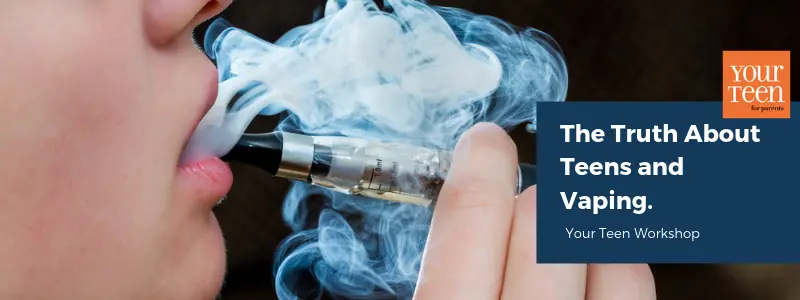Using e-cigarettes (vaping) is now a teen epidemic. Between 2017 and 2018, e-cigarette use among middle schoolers increased by 48 percent and among high schoolers by 78 percent, according to the U.S. Centers for Disease Control. More than a quarter of all high school students are frequent e-cigarette users. 28 percent vaping more than 20 times per month.
About a year ago, the trend hit home for Keri Williams, 42, a banking business systems consultant in Charlotte, North Carolina. That’s when the mom of five discovered that her children Amias, 16, and Kayla, 15, had been vaping on and off for about a year using a popular device called JUUL.
When Williams found out both of her teens were vaping, she made them keep their bedroom doors open unless they were changing clothes. She also took away their cellphones and media for one month. “I wanted to ‘go big’ so they understood just how serious this was,” Williams says.
She was right to be concerned. “Almost all e-cigarettes contain nicotine, even those that claim they don’t, because there’s no FDA oversight of the manufacturing,” says Jennifer Hobbs Folkenroth, national senior director, tobacco control at American Lung Association.
Nicotine is highly addictive; it’s what gets users hooked, Folkenroth says. Nicotine exposure during adolescence can harm a teen’s developing brain. The inhaled aerosol also contains other potentially harmful chemicals, such as acrolein and diacetyl, both of which have been linked to serious lung damage. Most recently, there have been increased reports of vaping-related lung illnesses and even some deaths due to the chemicals use in vaping products.
How to Get a Teenager to Stop Vaping
Many schools are implementing policies aimed at reducing vaping in school. This includes employing bathroom monitors and imposing consequences like suspension or even expulsion. But these measures may not be enough, especially if your teenager is becoming a more frequent—and addicted—user. If you suspect your teen is vaping, there are some things that parents should do.
1. Get your teenager talking.
Vaping is easier to hide because it doesn’t leave a telltale odor of traditional cigarettes or visible secondhand emissions, says Steven Schroeder, M.D., director of the Smoking Cessation Leadership Center at the University of California San Francisco.
To figure out what’s up with your teen, create an environment where it’s easier for your teen to talk about it, Dr. Schroeder says. Rather than asking your teen directly (You’re JUULing, aren’t you?), ask nonjudgmental questions, maybe while you’re driving somewhere, such as:
- I keep hearing about JUULing. Are your friends doing that?
- Is it popular at school?
- What do you think about it?
- How safe do you think it is?
2. Weave in the facts.
If you get the sense from your conversations that your teen is vaping, even just occasionally, such as at parties, talk about the risks. Be prepared to hear that JUULing isn’t a big deal.
“Many teens know cigarettes are bad for you but think vaping is inconsequential,” Dr. Schroeder says. Many teens don’t realize, for example, that all JUUL pods contain nicotine—as much as a pack of cigarettes. Recent reports of illnesses- and deaths – caused by vaping should bolster your argument here as well.
3. Appeal to their desire to be their own boss.
Appeal to your teen’s natural sense of rebellion. “Talk to teens about how the vaping industry is manipulating them,” Folkenroth says—for example, by making JUUL pods in flavors that appeal to young consumers, such as mango, crème, and fruit. (Under pressure from the Food and Drug Administration, JUUL recently agreed to eliminate some flavors from retail stores. However, they are still available online.)
You might say, for example: “The company is trying to make JUULing cool so you’ll get hooked and buy more JUUL pods. But shouldn’t you be the master of your own body and health? You’re the one who makes the decision about what goes in.”
4. Help your teen get help.
About a month after she banned vaping, text messages on her teens’ phones clued Williams in to the fact that they were vaping again. Determined to stop them, she ordered nicotine urine tests on Amazon and tested each teen daily until they were clean. Since then, she’s been randomly testing them a few times a month.
Parents can feel lost and even a little desperate when it comes to stopping vaping. But the American Lung Association cautions against this kind of screening. Instead they favor education, consistent parent-teen communication, positive support, and parents connecting teens with intervention or cessation programs.
This is Quitting is a smoking cessation program developed by Truth Initiative in collaboration with Mayo Clinic that offers a texting program to help quit e-cigarettes. Young people looking to join the program can text DITCHVAPE to 88709 for free and anonymous help quitting. The program delivers tailored messages via text that give age-appropriate quitting advice.
The American Lung Association also offers several programs to help educate teens on e-cigarette use, including Not On Tobacco (a voluntary youth cessation program) and Intervention for Nicotine Dependence: Education, Prevention, Tobacco and Health. To learn more, call 1-800-LUNG-USA or visit lung.org.
You may even send your teen to the pediatrician. “We know for combustible cigarettes, if your physician tells you not to smoke, it doubles your chance of quitting,” Dr. Schroeder says. “Just the authority of a pediatrician talking to a teen about not vaping in the absence of his parents might be helpful.”
For more great information on this topic, enroll in the Your Teen Workshop on Vaping, featuring a panel of experts discussing the facts and answering real parents’ questions.





